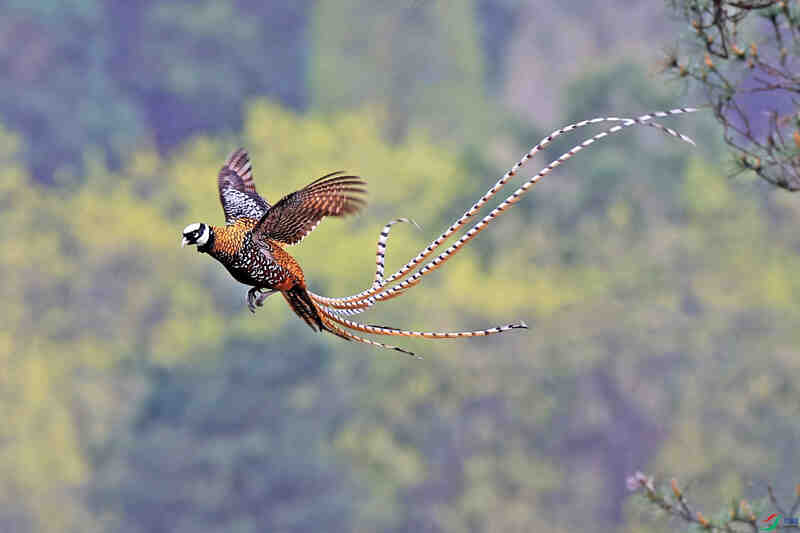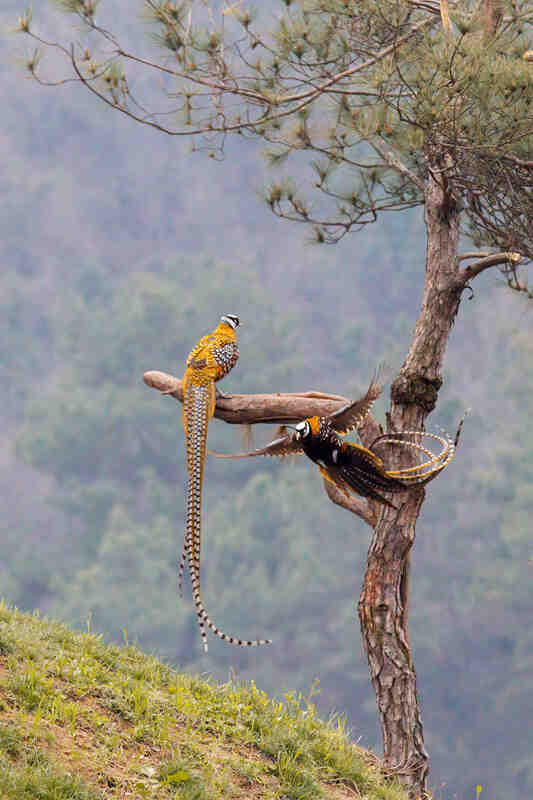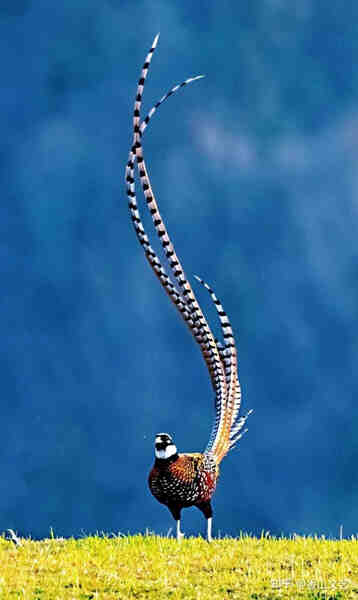Syrmaticus reevesii
IUCN
LCBasic Information
Scientific classification
- name:Syrmaticus reevesii
- Scientific Name:Zhai bird, ground chicken, long-tailed chicken, mountain pheasant,Syrmaticus reevesii,Reeves's Pheasant
- Outline:Landfowl
- Family:Galliformes Phasianidae L.Pheasant
Vital signs
- length:56-196cm
- Weight:0.7-1.736kg
- lifetime:About 20 years
Feature
Bird with the longest tail feathers
Distribution and Habitat
The White-crowned Long-tailed Pheasant is a bird species endemic to China. It is distributed in central and northern China in Henan, Hebei, Shaanxi, Shanxi, Hubei, Hunan, Guizhou, Anhui and other provinces. The Dongzhai National Bird Nature Reserve in Xinyang City, Henan Province is a reserve that mainly protects this species.
It mainly inhabits mountain forests at an altitude of 400-1500 meters. It particularly likes mountain broad-leaved forests or mixed forests with complex terrain, undulating terrain, many valleys and cliffs, steep slopes and dense forests. Sometimes it can reach an altitude of 2000-2600 meters.
Appearance
The male has a white head, chin, throat and neck, with a large white spot under the eye; the forehead, front of the eye, eye area, cheeks, ear area and back of the head are all black, forming a circle around the top of the head; there is an incomplete black collar behind the white neck; the back is golden yellow or brownish yellow, and each feather has a black feather edge, making the feathers scaly; the upper wing coverts are white, with broad chestnut feather tips, with narrow black edges in between; the tertiary and secondary flight feathers are black, with white and brown horizontal stripes and spots, and with broad brownish yellow terminal spots, which are decorated with black and chestnut thin edges outside; the outer vanes of the secondary flight feathers have only white spots and are stained with chestnut, and the brownish yellow feather tips are also limited to the outer vanes. The primary flight feathers are dark brown, with creamy yellow horizontal stripes on the outer vanes
Details
The white-crowned long-tailed pheasant is also known as Reeves's Pheasant. It has no subspecies and is a beneficial bird in the forest.

The white-crowned long-tailed pheasant mainly feeds on plant fruits, seeds, young shoots, tender leaves, flowers, tubers, roots, and seedlings and grains of crops. It is particularly fond of crops and often flies to the edge of farmland early in the morning and evening to steal crops, including soybean seeds, soybean sprouts, peas, corn, rapeseed, wheat seeds, wheat seedlings, rice, etc. Wild plants mainly include acorns, camellia seeds, azalea, Litsea cubeba, Ophiopogon japonicus, climbing beans, Houttuynia cordata, Masson pine seeds, Rubus chinensis, Viburnum, oats, oak, fern, sumac, Cyperus rotundus, Dioscorea var. erythrorhizome, Elaeagnus chinensis, Lespedeza chinensis, Castanea foetida, Carex, Pinellia ternata, Ranunculaceae, Cypress, Oak, and other leaves, flowers, fruits, tubers, and seeds of various trees, shrubs, and herbs. In addition, they also eat coleoptera and lepidoptera insects, snails, grasshoppers, katydids, and other animal foods.

White-crowned Long-tailed Pheasants usually move in groups in the valleys and open spaces in the dense forests and relatively open areas under the forests. They are active in the morning and afternoon and rest at noon. They are alert, with sharp hearing and vision. They will flee immediately if there is any movement. They are good at running and flying. It has strong and lasting flying ability and very fast flying speed, especially when gliding downward from a high altitude. It can also fly directly upward for a long distance. When flying quickly, it can use its long tail to control the flying direction and make a rapid landing, so it can move freely and flexibly in the forest.

The breeding season of the White-crowned Long-tailed Pheasant is from March to June. In mid-March, the flock begins to disperse, and the male birds begin to occupy the area. During this period, female birds often attract female pheasants by making short and rapid "fluttering" sounds by vibrating their wings in small amplitude in the early morning and evening. Usually, there is a one-male-one-female system, and occasionally one male can be seen with 2-3 female birds. When the male bird is courting, one side of the wing is slightly extended and drooped, the neck feathers are fluffy, and it keeps nodding and pecking at the ground, and the mouth makes a low "gu, gu, gu" sound. It has a strong territoriality. If another male pheasant enters the territory during the courtship period, fierce fights often occur. Usually, the nest is built on the ground in the bushes and grass under the forest or at the edge of the forest. It also builds a nest at the foot of a tree or under a bush. It is very hidden and simple. It is usually a shallow nest on the ground, padded with dead grass, pine needles, leaves and feathers, or without any padding. The size of the nest is 19-27 cm × 17-27 cm, and 5-10 cm deep. One nest is bred in a year, and each nest lays 6-10 eggs, usually 8-10 eggs, and there are up to 12 eggs. The eggs are oily gray, olive brown, olive cheese, light blue-gray, blue-yellow, oily blue-gray and leather yellow, with sparse light blue or gray-brown spots or no spots. The egg size is measured by 26 eggs, with an average of 30.2 (28.0-34.5) grams, 47.4 (45.0-50.2) mm × 36.0 (34.0-41.5) mm (Xu Weishu, Wu Zhikang, 1993), which is larger than the average measurement of 10 eggs in Beijing Zoo, 28.4 (26-32) grams, 34.9 (33.5-36.5) mm × 44.7 (42-49.5) mm (Zheng Zuoxin et al., 1976). After the eggs are laid, they begin to incubate, which is undertaken by the female bird. The female bird is very attached to the nest, especially in the later stage. When people come to the nest, they will not fly away. When people are driven away, they will even make intimidating and fighting gestures. After being forced to leave the nest, they often stay in front of the nest and refuse to go far away, and constantly jump up to attack people. The incubation period is 24-25 days.
According to the survey conducted by Chen Fuguan and others in Qinling Mountains, Shaanxi from 1983 to May 1986, the population density of the white-crowned long-tailed pheasant was 6.09 per square kilometer in 1983, 2.13 in 1984, and 1.53 in 1985, and the population density dropped sharply. The reason for the sharp decline of the population of the white-crowned pheasant is, on the one hand, deforestation, deforestation and land reclamation, which has caused the white-crowned pheasant to lose its living environment. For example, in the Mucuntai, Shawan, Zunyi, Guizhou, when it was surveyed in 1975, the forest was dense and the vegetation was good. There were about 50 white-crowned pheasants within 3 square kilometers; when it was surveyed again in 1983, most of the places had been reclaimed as farmland and the hills were exposed, and only 3 white-crowned pheasants were found. On the other hand, hunting, especially the phenomenon of poisoning white-crowned pheasants, is still quite common in some places, which also directly affects the population of white-crowned pheasants. The unofficial survey results in 2011 were even more bleak. The most optimistic estimate of the total number in the five counties surveyed was less than 30, and illegal capture was still rampant. If the protection status is not improved, it will soon become extinct.
Endangered factors: 1. Overhunting. 2. Habitat destruction. 3. Hunting for trade. 4. Hunted as a medicinal ingredient.
Listed in the IUCN Red List of Threatened Species in 2018 ver 3.1-Vulnerable (VU).
Listed in the International Bird Protection Committee (ICBP) World Endangered Bird Red List.
Listed in the China Red List of Endangered Animals: Endangered.
Listed in China's National Key Protected Wildlife List (February 5, 2021) as a first-class protected animal.
Protect wild animals and stop eating game.
Maintaining ecological balance is everyone's responsibility!








